Why Gen Z holds the key to the drinks industry’s next chapter
Hannah McDermid, a senior strategist at Thirst, offers four tips to get ahead of Gen Z’s coming drinking preferences.

Every beverage brand asks how to unlock the door to the Gen Z market. And at more than 2.5 billion people – already the world’s largest cohort – and with an estimated spending power in excess of £280bn, it’s easy to see why.
However, with that figure predicted to grow to a quarter of global income by 2030 – more than £25trn – where Gen Z’s attention will be in 10 years is the real answer everybody should be searching for.
Born between 1997 and 2012, Gen Z is a paradox for marketers. Studies suggest those of drinking age seek premium, ultra-personalized experiences in alcohol and beyond, set against a backdrop of greater mindfulness in how they spend their leisure time. With their sights on finding solutions to global and social challenges, their hedonistic action and altruistic beliefs – which live at odds today – will thrive together to create an exciting future for the beverage industry.
Here are four ways beverage brands will need to behave differently to stand out in this brave new Gen Z world.
Supercharge the new social scene.
Research suggests that 91% of Gen Z report physical or psychological problems due to stress, and they are more likely than any other cohort to have gone to therapy. As drinking continues to be the support rather than the focus in leisure time, controlled sobriety will evolve into experimental freedoms that fuel productivity, creativity, and social stimulation.
Advertisement
Once taboo, psychoactive ingredients, including cannabis, kava root, and mushrooms, will become a social staple for Gen Z, providing alternative gateways to functional microdosing and unlimited possibilities for mixology.
We can already see movement towards this. Supermodel Bella Hadid’s Kin Eurphorics arrived in the UK earlier this year, having already made a splash in the US market. Containing nootropic ingredients such as functional mushrooms, Hadid and co-founder Jen Batchelor says Kin will transform our typical drinking experiences into more conscious practices without removing the social element. This sector is in its relative infancy, but we expect to see it become the rule rather than the exception in the coming years.
A more mindful social scene also fuels more mindful drinking, and Gen Z will be looking for tech-enabled beverages to enhance wellness in their social routines. Beverages could follow the lead of innovators such as Nourished, which uses 3D printing to create gummy vitamins. We already see AR and VR used to elevate beverage experience, such as Brockman’s Orange Kiss partnership with Mr Fogg’s.
We expect to see AI’s developing capability harnessed for even greater personalization or circadian rhythms unlock new levels of ritual and a cocktail of innovative flavors.
Advertisement
Brands have endless opportunities to develop creative and ingenious solutions with powerful benefits outside their current realms. But to do so, brands must have clarity on why they exist and a coherent story to tell. Only then can they transcend the boundaries of innovation and meet untapped needs with relevant and meaningful benefits.
Amplify flavor diversity
Shaking up the West’s traditional staples, bold flavors from across the globe will continue celebrating the cultural richness and unlock beverage tourism. We already see this in food, with brands including Magic Dates, ZestyZ, and Better Sour.
The next step is for international flavors and street food to expand into street drinks inspired by fermentation, ancient grains and unusual textures, opening new doors for RTDs as canned cocktails premiumise. US drinks brand Crooked Owl, a fermented pineapple beverage with probiotic benefits, is among the early adopters.
Curiosity fuels the unexpected, with Gen Z seeking all the thrills, the spicy and the sour, to push their taste buds to the limits. Cross-cultural fusions with unexpected twists can inspire flavor collisions to invigorate spirits innovation beyond the incremental and hero communities worldwide. Demand for North American RTD hard seltzer SakeBomb – a low-calorie fusion of sake with bold western flavors – is already surging in countries including Canada and a signal of the growing appetite.
Suggested newsletters for you
Brands must move beyond borders to collaborate locally and unlock intriguing new flavors. To spearhead a new myriad of taste fusions, brands must ensure their curiosity builds on their core, expanding the product mix and creating new facets to the brand experience. Brands must also consider not just taste but textures, formats and processes to keep things fresh and tingle the taste buds of this experimental generation.
Make convenience a force for good.
Gen Z will wield more power to act on their desire to make a positive impact, and they’ll be looking a lot closer to home. According to UN predictions, 660 million people – equivalent to twice the population of Brazil – may face hunger by 2030. Wary of creating more resilient food and drink systems, Gen Z will look for tangible de-centralization where blockchain will become commonplace and hyper-local systems will come with greater accessibility and affordability.
For drinks, this means a shift from macro to micro, heroing regional beverage twists and connections with local suppliers. On-trade mixology will also adopt recipes and ingredients unique to their immediate radius, and the transparency of menus will become paramount.
Purpose-driven brands such as Doughp, which supports mental health causes; B-Corp certified New York Greyston Baking Co, which provides opportunities for workers from diverse backgrounds through open hiring while also donating all profits to its Greyston Foundation; and snack producer This Saves Lives, which supports organizations working to end hunger, are all examples of brands that are already using their purpose to help connect with Gen Z consumers without compromise to their product.
Brands must account for regional locality and be able to offer traceability back to the source to reassure Gen Z that their convenient choices are delivering real impact on the doorstep. While brands must communicate the functional positives, they mustn’t let them overtake pleasure. They must harness the relationships between local suppliers and mixologists to unleash desire, creativity and flavor closer to home.
Transition luxury spirit to entertainment
Set to become the biggest buyers of luxury goods by 2030, Gen Z drinkers are becoming ever more discerning. The role of luxury spirits will transcend from sophisticated craft to immersive experiences. On a quest for content, knowledge and theatre, experiential hedonism and progressive collaborations will redefine what a spirits brand can be.
There will be a greater balance between celebrities and individual content creators to celebrate their independent imaginations, experimentation and futuristic craft. Opportunities to deliver personalized 5D experiences help to create fluidity between digital and reality as Gen Z looks to consume more than just the beverage itself. We already see this through platforms like Yeay, a video e-marketplace that enables users to create shoppable videos for amateurs and brands.
Retail brands like Selfridges have already tapped into this by adding immersive gaming experiences in-store. At the same time, Louis Vuitton went viral on social media with its AR collaboration with artist Yoyoi Kusama involving famous landmarks.
Brands need to move their luxury spirits from exceptional products to elevated experiences to engage and provide constant content to entertain thirsty Gen Z. This means forging clear cultural connections, lifestyle benefits and bespoke communities to entertain, educate and ultimately make the drinking experience even more meaningful and memorable.
Ultimately, Gen Z needs beverage brands to be braver than ever. Defying convention, fostering creativity and championing genuine innovation while never losing sight of who they are to find success on the road to 2030.

